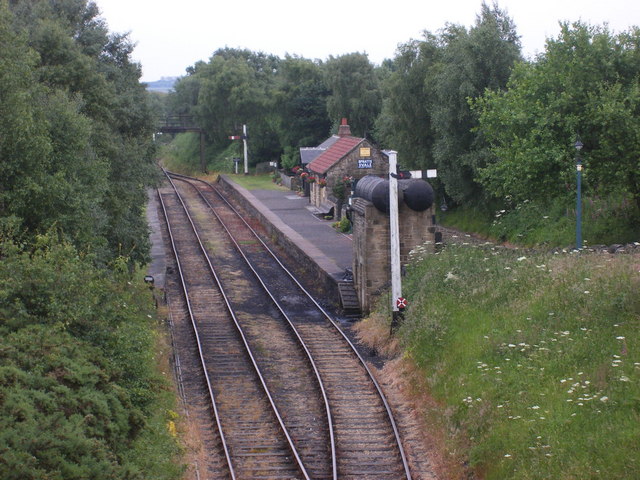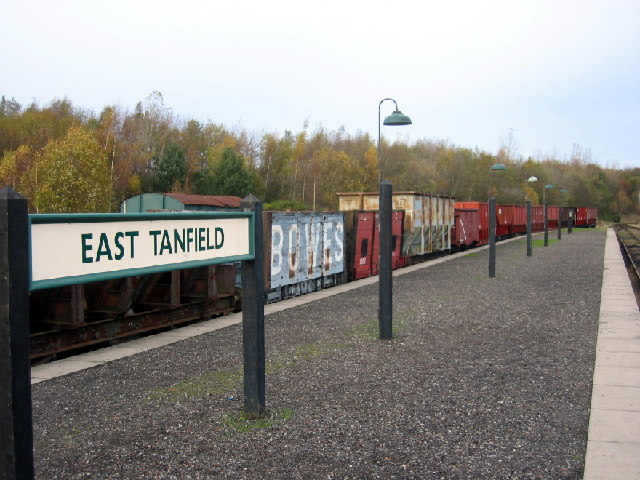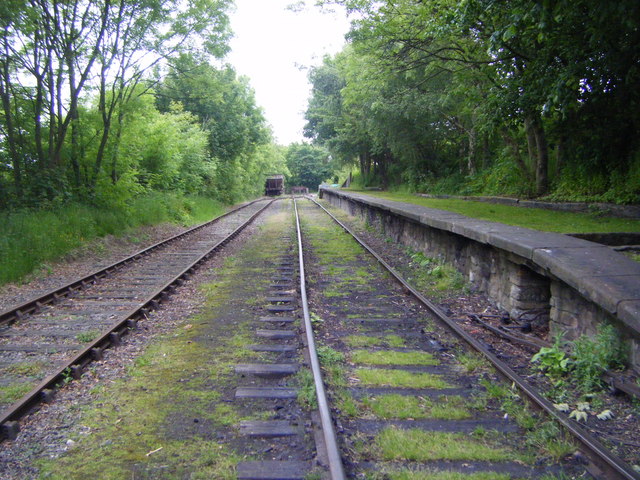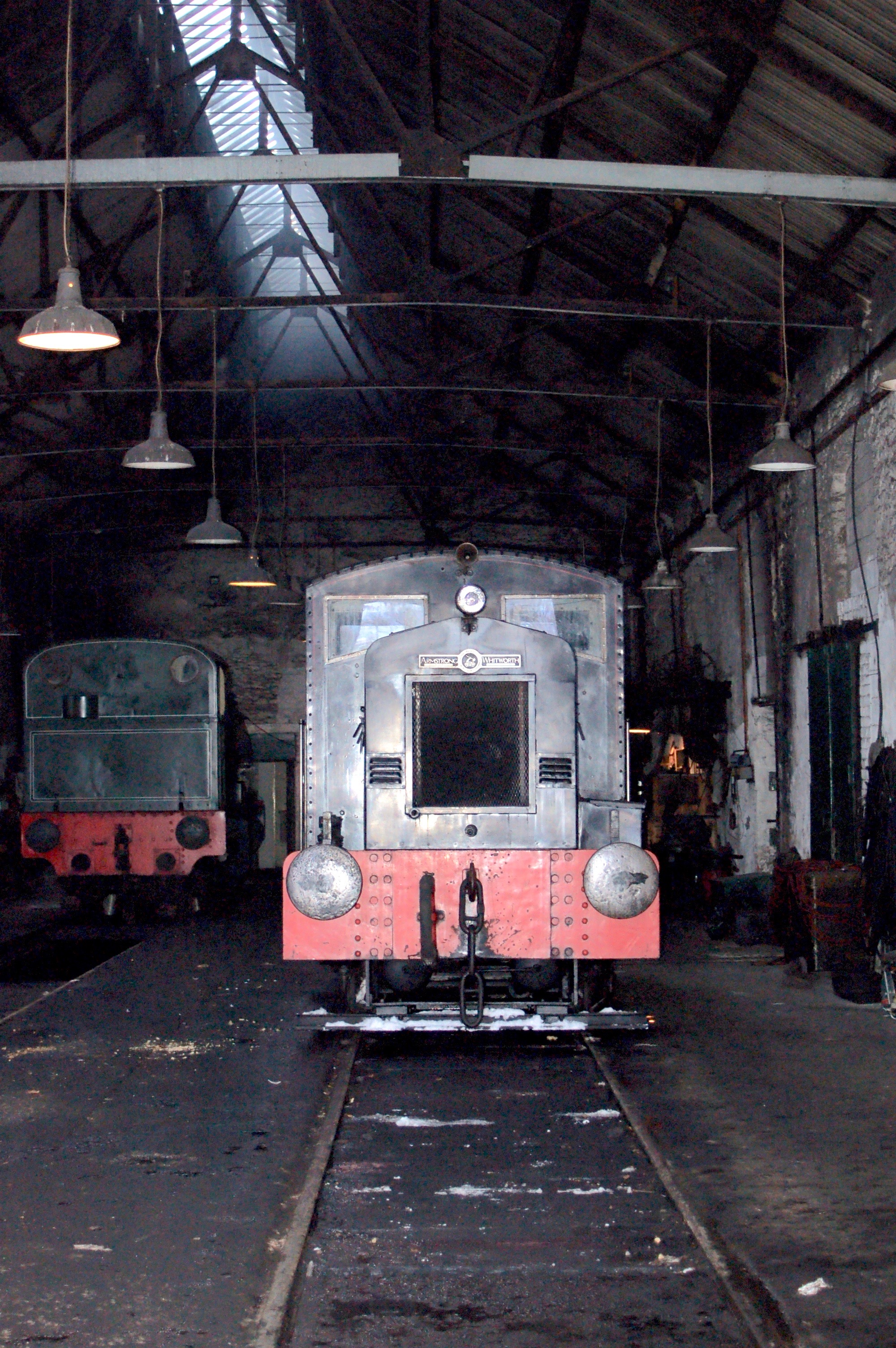Tanfield Waggonway on:
[Wikipedia]
[Google]
[Amazon]
The Tanfield Railway is a

 The early years of the railway as a preservation project concentrated on Marley Hill, preparing locos for steaming, working on the shed structure and acquiring basic needs such as water and electricity. Locomotives No.21 (Robert Stephenson and Hawthorns engine of 1954 0-4-0st) and No.5 (Malleable) were steamed in public in 1973. The first passenger train ran for a week August 1975, using locomotives No.21, No.32 and Sir Cecil A Cochrane, and a small carriage acquired from the British Steel Corporation site at Teesside.
The preserved line was first built from Marley Hill to the current northern terminus, Sunniside Station, with passenger trains beginning on 2 July 1981, and an official opening ceremony on 14 July 1982. Andrews House station just south of Marley Hill sheds was completed between 1987 and 1989 and was equipped with platforms, a water tower, a station building and a footbridge. The first train south to Causey was on 27 July 1991, with the official opening ceremony being held on 15 August 1991. The first train further south to the current end of the line at East Tanfield occurred on 18 October 1992. East Tanfield Station itself was opened in 1997. The Causey to Tanfield section is through a wood lined gorge.
Part of the reason the line was preserved was the fact Marley Hill shed remained open until 1970. The vintage machinery in the workshop is still capable of full locomotive overhauls. The oldest locomotive on the railway was built in Gateshead in 1873, and all of the railway's carriage stock dates from the 19th Century.
The early years of the railway as a preservation project concentrated on Marley Hill, preparing locos for steaming, working on the shed structure and acquiring basic needs such as water and electricity. Locomotives No.21 (Robert Stephenson and Hawthorns engine of 1954 0-4-0st) and No.5 (Malleable) were steamed in public in 1973. The first passenger train ran for a week August 1975, using locomotives No.21, No.32 and Sir Cecil A Cochrane, and a small carriage acquired from the British Steel Corporation site at Teesside.
The preserved line was first built from Marley Hill to the current northern terminus, Sunniside Station, with passenger trains beginning on 2 July 1981, and an official opening ceremony on 14 July 1982. Andrews House station just south of Marley Hill sheds was completed between 1987 and 1989 and was equipped with platforms, a water tower, a station building and a footbridge. The first train south to Causey was on 27 July 1991, with the official opening ceremony being held on 15 August 1991. The first train further south to the current end of the line at East Tanfield occurred on 18 October 1992. East Tanfield Station itself was opened in 1997. The Causey to Tanfield section is through a wood lined gorge.
Part of the reason the line was preserved was the fact Marley Hill shed remained open until 1970. The vintage machinery in the workshop is still capable of full locomotive overhauls. The oldest locomotive on the railway was built in Gateshead in 1873, and all of the railway's carriage stock dates from the 19th Century.

 *
*
File:Tanfield Railway pic 6.jpg, Marley Hill yard
File:Tanfield Railway pic 8.jpg, Locomotive ''Stagshaw''
File:Tanfield Railway pic 14.jpg, Diesel works train passing Marley Signal box on the running line. A headshunt from Marley Yard crossed the line here for a few yards before it was lifted in 2012.
The Tanfield Railway (Causey Extension) Light Railway Order 1991
Sunniside Local History Society
Official site
Tanfield Railway photo gallery
BBC Wear
The Grand Allies
Co-Curate (Newcastle University) {{authority control Heritage railways in County Durham Heritage railways in Tyne and Wear Museums in County Durham Railway museums in England Horse-drawn railways Railway lines opened in 1725 1725 establishments in Great Britain 1647 establishments in England
heritage railway
A heritage railway or heritage railroad (US usage) is a railway operated as living history to re-create or preserve railway scenes of the past. Heritage railways are often old railway lines preserved in a state depicting a period (or periods) i ...
in Gateshead
Gateshead () is a large town in northern England. It is on the River Tyne's southern bank, opposite Newcastle upon Tyne, Newcastle to which it is joined by seven bridges. The town contains the Gateshead Millennium Bridge, Millennium Bridge, Sage ...
and County Durham
County Durham ( ), officially simply Durham,UK General Acts 1997 c. 23Lieutenancies Act 1997 Schedule 1(3). From legislation.gov.uk, retrieved 6 April 2022. is a ceremonial county in North East England.North East Assembly â€About North East E ...
, England. Running on part of a former horse-drawn colliery wooden waggonway, later rope & horse, lastly rope & loco railway. It operates preserved industrial steam locomotives. The railway operates a passenger service every Sunday, plus other days, as well as occasional demonstration coal, goods and mixed trains. The line runs between a southern terminus at East Tanfield, Durham, to a northern terminus at Sunniside, Gateshead
Sunniside is a village in the Metropolitan Borough of Gateshead, which is located around from Newcastle upon Tyne. Prior to the creation of the county of Tyne and Wear in 1974, it was part of Whickham Urban District, which in turn formed a part o ...
. Another station, Andrews House, is situated near the Marley Hill
Marley Hill is a former colliery village about six miles to the south west of Gateshead, near the border between Tyne and Wear and County Durham. It has been part of the Metropolitan Borough of Gateshead since 1974. Prior to this it was part o ...
engine shed. A halt also serves the historic site of the Causey Arch. The railway claims it is "the world's oldest railway" because it runs on a section dating from 1725, other parts being in use since 1621.
The railway is run by three bodies: "Friends of Tanfield Railway", "Tanfield Railway Trust" which owns the railway, the locomotives and rolling stock and "The Tanfield Railway Company" which operates the railway.
"The Tanfield Railway Company" is split into four departments; each has a manager and director: Engineering who maintain locomotives, Operations including drivers and guards, Carriage & Waggon who preserve carriages, and Commercial which operates shops, events and the passenger side of operations.
Colliery railway
The Tanfield Waggonway was built by the Grand Allies (an association of coal-owning families, including the Bowes, Liddells, Ords and Montagues, who joined together to overcome wayleave difficulties from about 1720) to transport coal more reliably & cheaply from inland collieries of County Durham, to thestaith
A wharf, quay (, also ), staith, or staithe is a structure on the shore of a harbour or on the bank of a river or canal where ships may dock to load and unload cargo or passengers. Such a structure includes one or more Berth (moorings), berths ...
s on the River Tyne
The River Tyne is a river in North East England. Its length (excluding tributaries) is . It is formed by the North Tyne and the South Tyne, which converge at Warden Rock near Hexham in Northumberland at a place dubbed 'The Meeting of the Wate ...
at Redheugh. From here the coal was transported in keels downriver to Shields, then transferred to colliers (bulk coal carrying ships) for the voyage down the North Sea coast to south east England. Many older shorter coal waggonways existed to the north of the present heritage line, in the Whickham and Lobley Hill
Lobley Hill is located in the west of the old County Borough of Gateshead within the Metropolitan Borough of Gateshead in Tyne and Wear, North East England having been previously part of the parish of Whickham.
In its Demographic Profile for ...
areas, but the Tanfield Waggonway was a much longer and heavily engineered route which gave the Grand Allies market dominance all year round. (Although supply to SE England was still subject to North Sea winters.) The Tanfield route was in continuous use from 1725 until final closure in 1964.
The route and structures of the oldest section of the now preserved part of the line, between Sunniside and Causey, dates from 1725, and is thus the world's oldest railway still in operation.
(The Middleton Railway makes an alternative claim to be the oldest railway, as the first railway granted powers under the first railway Act of Parliament in 1758.) The Causey to East Tanfield section was built in 1839.
The Marley Hill engine shed was built by 1854, and was in industrial use until 1970. The shed is on the Bowes Railway
The Bowes Railway, built by George Stephenson in 1826, is the world's only operational preserved standard gauge cable railway system. It was built to transport coal from pits in Durham to boats on the River Tyne. The site is a scheduled mon ...
, whereas locos used on the Tanfield branch were stabled at the nearby Bowes Bridge MPD (a sub-shed of Gateshead), the coaling ramp and turntable pit of which are still visible adjacent to the track between Andrews House and Sunniside. A winding engine occupied the Bowes Bridge site from 1840–81, a locomotive shed from 1881-1962. The headshunt by Marley Hill signal box is the point where the west-east Bowes Railway crossed the south-north Tanfield branch. When the Tanfield Railway began running trains in 1977 a curve was installed to allow Marley Hill locos and trains onto the Tanfield Branch. Marley Hill engine shed is the oldest in the world still used for its original function. As collieries on the NCB line closed in the 1960s, coal was brought by road to adjacent drops for onward rail transport, and the shed saw further use servicing other local colliery locomotives.
Originally a wooden railed horse drawn waggonway, conversion to a steel railed railway began in 1837, and by 1840 was complete as far as Tanfield Moor Colliery, using stationary steam engines, gravity inclines and horses. In 1881, while operated by the North Eastern Railway, steam locomotives replaced the stationary steam engines and horses. Although primarily a coal railway, it did carry some passengers. The railway closed when the last colliery on the line at East Tanfield ceased production in 1964.
Preservation

 The early years of the railway as a preservation project concentrated on Marley Hill, preparing locos for steaming, working on the shed structure and acquiring basic needs such as water and electricity. Locomotives No.21 (Robert Stephenson and Hawthorns engine of 1954 0-4-0st) and No.5 (Malleable) were steamed in public in 1973. The first passenger train ran for a week August 1975, using locomotives No.21, No.32 and Sir Cecil A Cochrane, and a small carriage acquired from the British Steel Corporation site at Teesside.
The preserved line was first built from Marley Hill to the current northern terminus, Sunniside Station, with passenger trains beginning on 2 July 1981, and an official opening ceremony on 14 July 1982. Andrews House station just south of Marley Hill sheds was completed between 1987 and 1989 and was equipped with platforms, a water tower, a station building and a footbridge. The first train south to Causey was on 27 July 1991, with the official opening ceremony being held on 15 August 1991. The first train further south to the current end of the line at East Tanfield occurred on 18 October 1992. East Tanfield Station itself was opened in 1997. The Causey to Tanfield section is through a wood lined gorge.
Part of the reason the line was preserved was the fact Marley Hill shed remained open until 1970. The vintage machinery in the workshop is still capable of full locomotive overhauls. The oldest locomotive on the railway was built in Gateshead in 1873, and all of the railway's carriage stock dates from the 19th Century.
The early years of the railway as a preservation project concentrated on Marley Hill, preparing locos for steaming, working on the shed structure and acquiring basic needs such as water and electricity. Locomotives No.21 (Robert Stephenson and Hawthorns engine of 1954 0-4-0st) and No.5 (Malleable) were steamed in public in 1973. The first passenger train ran for a week August 1975, using locomotives No.21, No.32 and Sir Cecil A Cochrane, and a small carriage acquired from the British Steel Corporation site at Teesside.
The preserved line was first built from Marley Hill to the current northern terminus, Sunniside Station, with passenger trains beginning on 2 July 1981, and an official opening ceremony on 14 July 1982. Andrews House station just south of Marley Hill sheds was completed between 1987 and 1989 and was equipped with platforms, a water tower, a station building and a footbridge. The first train south to Causey was on 27 July 1991, with the official opening ceremony being held on 15 August 1991. The first train further south to the current end of the line at East Tanfield occurred on 18 October 1992. East Tanfield Station itself was opened in 1997. The Causey to Tanfield section is through a wood lined gorge.
Part of the reason the line was preserved was the fact Marley Hill shed remained open until 1970. The vintage machinery in the workshop is still capable of full locomotive overhauls. The oldest locomotive on the railway was built in Gateshead in 1873, and all of the railway's carriage stock dates from the 19th Century.
Causey Arch
The current preserved line passes near to Causey Arch, the oldest surviving railway bridge in the world. It was built to carry a new branch from the route of the now preserved line to a site known as Dawson's Drift. Built between 1725 and 1727, at and , it was the largest single-span bridge in Britain, and remained so for 30 years.Locations

Steam locomotives
As of 2017, the railway has become the home to a large collection of industrial steam engines, with 28 in all, though only three are operational. One is undergoing repairs and three more are under overhaul for future operation, with the other 21 around the Marley Hill site.Operational locomotives
Locomotives under overhaul/restoration
Stored locomotives
Diesel and electric locomotives
 *
* AEG
Allgemeine Elektricitäts-Gesellschaft AG (AEG; ) was a German producer of electrical equipment founded in Berlin as the ''Deutsche Edison-Gesellschaft für angewandte Elektricität'' in 1883 by Emil Rathenau. During the Second World War, AEG ...
Bo-BoBo-BoWE no. 1565 / NCB No.9, built in 1913 for the Harton Coal Company. Withdrawn in 1988. On display in Marley Hill Yard. Awaiting cosmetic restoration in the future.
* Andrew Barclay Sons & Co. 0-6-0DH no. 615, built in 1977. Operational, on hire to the Aln Valley Railway
The Alnwick branch line is a partly closed railway line in Northumberland, northern England. A heritage railway currently operates a mile of the line, which originally ran from Alnmouth railway station, on the East Coast Main Line, to the town o ...
.
* Armstrong Whitworth no. D22, built in 1933. Operational.
* English Electric and Baguley 2-2wDHR no. 3565, built in 1962. On display.
* F.C. Hibberd & Co Ltd Planet 4wDM no. 3716, built in 1955. Operational.
* Fowler 0-6-0DH no. 4240010 ''No. 6'', built in 1960. Undergoing restoration.
* Hawthorn Leslie 4w-4wBE no. 3872 ''Derek Shepherd'', built in 1936. On display.
* Hunslet Engine Company 0-6-0DH no. 6612 ''No. 501'', built in 1965. Stored awaiting restoration.
* Robert Stephenson and Hawthorns 0-4-0DM no. 6980 ''Camel'', built in 1940. On display.
* Robert Stephenson and Hawthorns 0-6-0DM no. 7697 ''Beryl'', built in 1953. On display.
* Robert Stephenson and Hawthorns 0-6-0DM no. 7746 ''Bromborough No. 2'', built in 1954. On display.
* Robert Stephenson and Hawthorns 0-4-0DM no. 7901 ''Husky'', built in 1958. Operational.
* Robert Stephenson and Hawthorns Bo-BoWE no. 7078 ''Kearsley No. 3'', built in 1944. On display.
* Ruston and Hornsby 0-4-0DE no. 418600 ''T.I.C No. 35'', built in 1958. On display.
* Siemens
Siemens AG ( ) is a German multinational conglomerate corporation and the largest industrial manufacturing company in Europe headquartered in Munich with branch offices abroad.
The principal divisions of the corporation are ''Industry'', '' ...
4wWE no. 862 / NCB No.10, built in 1913. Sister locomotive to NCB No.9 (see above). On display, cosmetically restored.
;Key
* BE = battery-electric
* DE = diesel-electric
* DH = diesel-hydraulic
* DM = diesel-mechanical
* WE = overhead wire electric
Coaching stock
All of the railways coaches are wooden bodied, Victorian coaches. * TR No.1 Open Balcony Coach ex GWR Van * TR No.2 Open Balcony Coach ex GWR van * TR No.3 Open Coach with Guards Van eX LNER Ballast brake van * TR No.4 Open Coach with Guards Van ex LNER Ballast brake van * TR No.5 Compartment Coach. Originally a GNR Coach * TR No.6 Compartment Coach. Originally a GNR Coach * TR No.7 Open Poppleton Coach with Guards Van. Originally an NER Director's Saloon * TR No.8 Compartment Coach with Guards Van. Originally an MS&L Brake Van * NER No.256 Compartment Coach built 1878 * NER No.818 Compartment Coach *NER No.A15 Compartment bogie carriage The railway also has other unrestored coaching stock.Additional photographs
References
Further reading
The Tanfield Railway (Causey Extension) Light Railway Order 1991
Sunniside Local History Society
External links
Official site
Tanfield Railway photo gallery
BBC Wear
The Grand Allies
Co-Curate (Newcastle University) {{authority control Heritage railways in County Durham Heritage railways in Tyne and Wear Museums in County Durham Railway museums in England Horse-drawn railways Railway lines opened in 1725 1725 establishments in Great Britain 1647 establishments in England